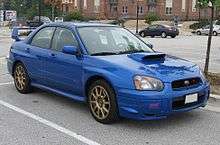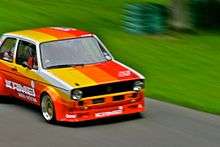Sport compact
A sport compact is a high-performance version of a compact car or a subcompact car. According to Motor Trend in a comparison entitled "Small, Fast, Fun", the sports compact car has to accomplish the multiple duties of a "family car" and a "daily driver" - thus having more than two doors and seating at least four passengers - while also being "fun to drive" on all roads and in town.[1]
Characteristics
There is no precise definition and the description is applied for marketing purposes to a wide variety of models, but typical "sport compacts" are front engined, front-wheel drive or all-wheel drive coupés, sedans, or hatchbacks driven by a straight-4 gasoline engine. In most cases, they are versions of mass-market cars that are factory produced with additional features and upgrades. Performance-oriented sport compacts generally focus on improving handling and increasing performance by engine efficiency, rather than increasing engine size. Sport compacts often feature external body modifications to improve aerodynamics or house larger wheels.
"Econosport" is a rarely used term for a sport version of a small economy car.[2]
A partial list of some of the sport compact cars is here.
Market trends

Early sport compacts were based on performance variants of compacts - Ford of Europe was an early manufacturer where its UK division sold a special edition of the Ford Cortina as a limited edition Lotus-Cortina during the mid 1960s, and later using the Cortina MkII platform when the Capri was designed as a European version of the USA market Mustang using a Cortina platform and locally sourced parts from the Escort.
The 1980s and 90s would be considered as the evolution of the modern day sport compact - in the USA domestic manufacturers GM and Ford began phasing out its midsize rear wheel drive automobiles which underpinned the G platform and variants of the Fox body when its front wheel drive replacements with the exception of its musclecar survivors (in this case, the GM F bodies and Ford Mustang). GM introduced a sport and appearance package with its J platform coupes (Cavalier Z24, Sunbird GT), and Ford followed suit when they refreshed its EXP coupe with the front sheetmetal of its facelifted Escort. These, however, were sport appearance packages optioned on a mass market compact with moderate sales. By the mid-1990s when the SUV began outselling passenger cars, this was where the demise of the musclecar survivors except the ponycars diverged - some transitioned to the sport truck scene (which was still body-on-frame, front engined, and rear wheel drive and the modern sport compact evolved - GM marketed some performance variants of its J platform, and Ford selling the Probe (which was corporately shared with a concurrent Mazda product). Chrysler Corporation had some of its front wheel drive compacts available with a sport package since the mid-1980s including those based on its Omni/Horizon twins.
Sport compacts remain one of the largest segments of the performance car market in Europe and Japan, and is seeing a resurgence in North America after declining sales in the 1990s.
Japanese manufacturers such as Honda, Mazda, Mitsubishi, Nissan and Subaru have continued to release new generations of sport compacts, such as the Honda Civic Si, Mazdaspeed3, and the Nissan Sentra SE-R Spec V. General Motors and other American companies has responded with the Saturn Ion Red Line, the Pontiac G5 GT, and the Chevrolet Cobalt SS. Dodge released the Neon SRT-4 in this class, and later the Caliber SRT-4, high-performance versions of their respective models.
European manufacturers have long offered multiple high-performance compacts in Europe and many of these are imported to North America. These are called hot hatches or warm hatches depending on engine power as they are available as hatchbacks. They include the VW Golf GTI (which was first announced in 1975), Volkswagen R32 and Mini Cooper.
Tuning

After-market modifications or customization is commonly referred to as tuning. This has given rise to the term "tuner" for the owners of modified sport compacts (and other vehicle classes), and by extension, their automobiles. As with trucks and other vehicle categories, there is a large market for performance-enhancing equipment designed to fit small cars. "Tuning" is also symbolized by cosmetic and non-performance related vehicle modifications. It is the subject of some controversy whether to recognize a compact "tuner" car that has been modified to offer lesser vehicle performance than a "sport compact".
Cosmetic tuning may include changing the interior (such as changing the shift knob and steering wheel as an example) and exterior decoration, installation of a DVD combined with a powerful sound system, adding neon headlights and other aftermarket lighting systems to name but a few. Performance tuning can include the modification of the car's aerodynamics, adding a nitrous oxide injection system, changing wheels and tires, chip tuning, installation of a weighted gear knob and a short shifter, changing filters and so on.
Motorsport

Small cars with high power ratings can be formidable racing vehicles. The Sports Car Club of America has long hosted races for compact cars. More recently, sport compacts have become so popular that the Australian National Drag Racing Association (ANDRA) (www.andra.com.au) now have special classes for sport compact racing, and the National Hot Rod Association (NHRA) has made sport compact cars eligible to compete in the Lucas Oil Sportsman Series, and Sport Compact "Pro RWD" type cars are used in the NHRA Pro Stock category as the Chevrolet Cobalt is used as the manufacturer's car in the class. All these classes are officially sanctioned by ANDRA and are recognised through a series of successful events and National Records.
Some highly modified sport compact dragsters can accelerate from 0-60 mph in less than four seconds.[3]
Sport compacts are fairly popular for autocross competitions. The Acura Integra, Toyota Celica, and MINI Cooper are some of the more successful sport compacts within their classes.
Sport compact cars have been the backbone of rallying, rallycross and drifting since their beginnings.
The former NASCAR Goody's DASH Series found new life in 2005 when acquisitioned by International Sport Compact Auto Racing Series (ISCARS) DASH Touring,[4] which tours primarily on asphalt ovals throughout the southeast. In 2008 the series accepted the sanction of American Speed Association (ASA).[5] The TC 2000 Championship is one of the touring car racing series which involves sport compacts.
References
- ↑ "Small, Fast, Fun: Sport Compact Car Comparison". Motor Trend. January 5, 2009. Retrieved March 13, 2017.
- ↑ DiPietro, John (10 May 2002). "2002 Econosport Sedans Comparison Test". Edmunds. Retrieved 26 April 2013.
- ↑ "Superfour Challenge - - Car and Driver - November 2005". Car and Driver. Archived from the original on 2007-10-16. Retrieved 2011-11-08.
- ↑ "ISCARS". Iscarsonline.com. 2011-03-23. Retrieved 2011-03-31.
- ↑ "ASA Racing". ASA Racing. Retrieved 2011-03-31.